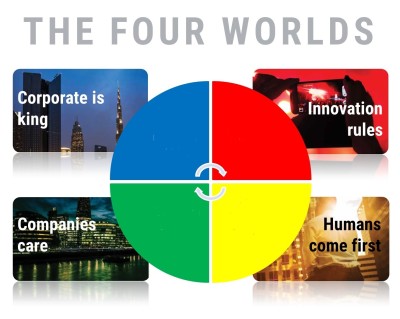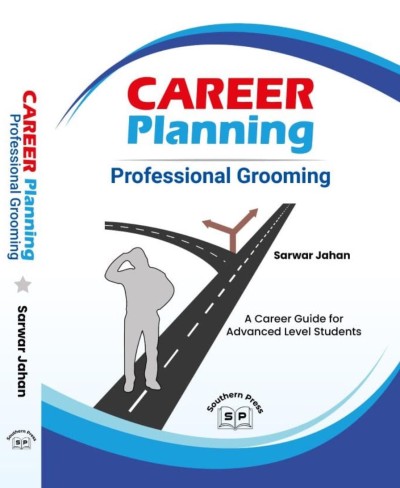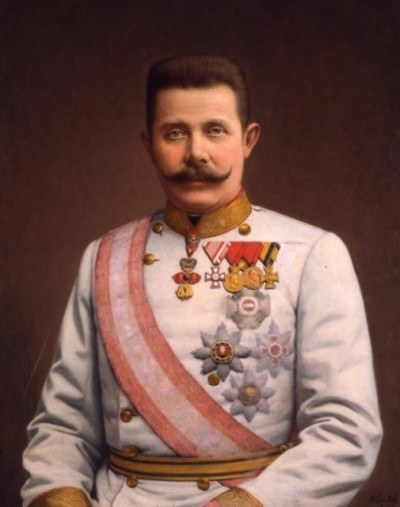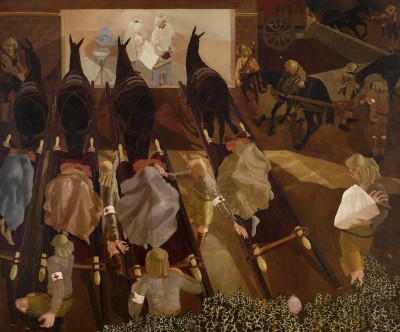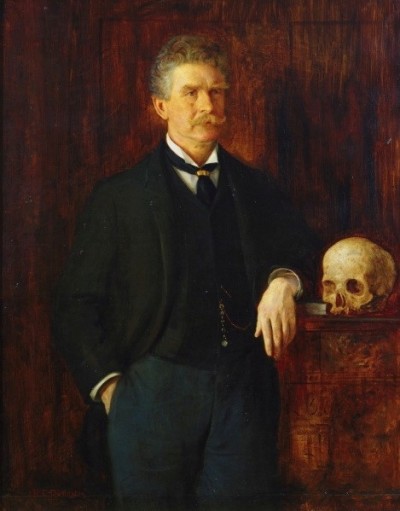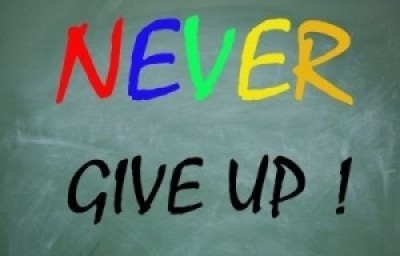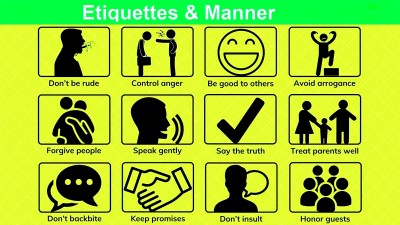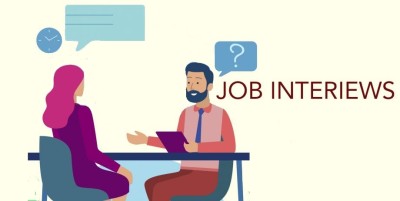Course description
Chapter 14.
Career in Changing World of Work
Disruptive innovations are creating new industries and business models, and quenching old ones. New technologies, data analytics and social networks are having a huge impact on how people communicate, collaborate and work. As generations collide, workforces become more diverse and people work longer; traditional career models may soon be a thing of the past. Many of the roles and job titles of tomorrow will be ones we’ve not even thought of yet. How are these developments going to affect our life and business!
No exploration of the future of work could ever be definitive. Indeed, one of the defining characteristics of our age is its
ability to surprise and confound. However, while things happen that we cannot predict, we can still be prepared.
THERE IS A PERVASIVE ANXIETY about the future of higher education. Spiraling costs combined with seismic changes in the global workplace raise questions about whether a bachelor’s degree is still worth the cost.
They will go into a job market that looks especially bleak for young people. Many college graduates are unemployed or working minimum-wage jobs. Still more are working in jobs that don’t require a college credential. Some of the troubles facing new graduates can be attributed to the post-recession economy. But there are larger forces at work that are transforming the nature of employment —forces that colleges and universities have been slow to recognize, much less respond to.
The Transformation of the Workplace The changing nature of work is reflected in a host of converging trends. For example, the onrush of new technologies is rendering many jobs—even entire occupations— obsolete. Automation is hardly a new phenomenon, but some analysts say the combination of fast computers, global networks, and sophisticated software is eliminating more jobs than it creates.
Just as technology is reordering the American workplace, globalization is also changing the rules of the game. To maximize efficiency and protect the bottom line, many employers are shifting production and services abroad. Companies are no longer bound in the same way to their employees or the communities in which they live and work.
Given the need for speed and adaptability, employers increasingly rely on a revolving cast of freelancers, independent contractors, and temporary workers—who receive little or nothing in the way of benefits or job security. Once a small segment of the workforce, these workers now make up about one-third of the US workforce. That number is expected
to rise to 40 percent—some 60 million people—by the year 2020.
Today the world of work is filled with different definitions of success and failure. Traditional Religious believers believe success is determined by forces out of humans controlled, some propagate the philosophy of “Luck” as the key determinant of success. In an ever changing world where the only constant thing is change, it simply takes more than luck to succeed.
The world of work is changing rapidly! The world of work is changing at the speed of light, and many professionals are finding it difficult to keep up with the dizzying speed of change. In fact, more than likely, you have heard it said a few times, that the only thing that’s constant is change itself. Although it’s very cliché, it’s also very true. With this speed of change in the world of work, how can we keep up? The answer is that we have to be very strategic about how we make plan and manage our career. Unemployed person shouldn’t be concerned about finding a job, but should be focused on creating the best possible career for him or her.
Disruptive innovations are creating new industries and business models, and destroying old ones. New technologies, data analytics and social networks are having a huge impact on how people communicate, collaborate and work. As generations collide, workforces become more diverse and people work longer; traditional career models may soon be a thing of the past. Many of the roles and job titles of tomorrow will be ones we’ve not even thought of yet.
“Career for Life” vs “Career for Me”
A well groomed professional with demand skills should know that, it will be suicidal, if he or she sit back and wait for organizations to provide a career for life. This environment gone, now onward strategy is to think about a career for individual, because your interests, knowledge, skills, abilities, and the vision you have for your work, align with the organization’s goals. When you think about it, the “career for me” mindset is very empowering because professionals take control of their careers, and they make better choices when exploring new career opportunities.
“Career for Me”
Although it will take time, shifting to a “career for me” mindset is straightforward, and if this is something that you’d like to explore, here is what you should do:
· Identify your strengths and interests.
· What strengths would you like to use, and interests you would like to explore?
· What personal vision do you have for your career?
· When you think of your ideal organization, what comes to mind? What is negotiable and non-negotiable?
· Make a list of organizations that you have always admired.
· Conduct preliminary research to identify organizations that fit your criteria.
· Add the names to the list of organizations that you made.
· Conduct detailed research on the organizations on the list - read their websites, press releases, check their company pages on LinkedIn, read the profiles of the senior executives, talk to current and former employees.
· Analyze the information, using what you discover as a filter for which organizations to focus on.
· Identify the top three things each of the organizations on your list is struggling with that you can address. In other words, find the company’s top strategic imperatives.
· On LinkedIn, start connecting with decision makers at these companies. Do not use the standard LinkedIn invitation, but personalize it using the information you discovered. Also connect with hiring managers.
· Make sure that your profile is complete and up-to-date. Upload a portfolio of your work, and if it makes sense, create a SlideShare presentation of what you can do for prospective employers. Get recommendations from people who know your work.
· Share valuable and interesting information that’s of interest to them.
· After you have consistently shared valuable information over a few months, request a conversation with the decision makers in your target companies. This could be a telephone conversation, and when the time is right, request a face-to-face meeting.
During the conversations, you are also confirming what you discovered from research to make sure that your interests, knowledge, skills and abilities align with the organization's needs, goals and objectives.
· Why Work
Think a moment why we work, what will be impact of my career decisions, compare different types of employers and employment and analyze changes affecting the workplace, now propose ways to develop skills needed for the workplace.
Earning a living is an important reason for working but it is not the only reason. We work to achieve, support ourselves, feel proud and competent. We work to satisfy our self from doing a job well and contributing to society. These work satisfaction and achievement helps us develop our skills and gain knowledge. Sense of belonging by build satisfying relationships with coworkers and enjoy being part of a team. At work good performance in a job gains the approval of others and boosts our self-esteem. we change jobs from time to time to gain more experience, earn more money, or simply to do something different.
Types of Employment
1. Full Time.
2. Part Time.
3. Contract.
4. Temporary.
5. Freelance.
An entrepreneur is someone who sets up and operates a business.
Today's workplace is constantly changing. Developments around the world affect the demand for certain goods an services.
1. Economics trends influence consumer spending.
2. Technology changes th e way some work is done.
3. Companies have to adapt to stay in business.
4. The US is part of the global economy, the national economies around the world are linked by trade.
Employers search people who can demonstrate basic academic skills (reading, writing, math) , thinking skills, technology skills, interpersonal skills, and management skills. By developing a wide variety of skills and abilities, Education, training, and skill development will be a continual part of career development in the changing world of work. Learning is a lifelong process
Skills needed then
Skills need now – Admin Assistant
• Typing
• Extensive IT skills,
• Diary management
• Coordinating senior leadership figures in multiple locations
• Basic computing skills
• Arranging online webinars and conference calls with multiple nationalities and regions
• Problem solving
• Critical thinking
Jobs and Careers
A job is work that people do for pay with out any training.
A career is a series of related jobs built on a foundation of interest, knowledge, training, and experience.
***An occupation is the type of work you do
Technology has long changed the way we work
Changes in the world affect what work is available for people to do and the way in which they do it.
Due to Technology, the Global Economy and the Job Market is in our thump. As part of the global economy, consumers can buy products from around the world. The global economy is the worldwide linkage of national economies. It has a direct impact on the job market. Keeping informed about developments in the global economy can help you learn more about the worldwide job market.
Advances in technology are constantly changing how people work. People working in different fields use a wide range of technology to help them do their work more quickly and efficiently. Modern technology influences not only what work you do, but also how and where you do it.
Today’s Workplace
Advances in technology are constantly changing how people work. People working in different fields use a wide range of technology to help them do their work more quickly and efficiently. Modern technology influences not only what work you do, but also how and where you do it.
- Team-a organized group that has a common goal.
- outsourcing- when a business hires other companies to produce their good or service.
-Telecommuting-working from home. Most jobs will supply with a computer
-A team is an organized group that sets goals, makes decisions, and implements actions within a company.
-Team workers collaborate on projects rather than doing what a manager tells them to do.
The Job Outlook
What does the future of that job look like? Salary, job market, new technology
Lifelong Learning- continually learning about new technologies, practices, and new ideas throughout your life.
Diversity in Workplace
You will encounter people from different countries, cultures, backgrounds and generations. They will not all be like you!!!
• It matters less what we know and more what we can find
• It matters less what we do ourselves and more how we collaborate with others
• It matters less how we look when we work and more how much work we get done
• It matters less what skills we have mastered in the past and more how well we learn new skills in the future
• Public Sector is funded by tax dollars. Such as : police officers, firefighters, teachers in public schools etc.
• Private Sector is the part of the economy that is not controlled by the government .
Types of Employment
1. Full Time.
2. Part Time.
3. Contract.
4. Temporary.
5. Freelance.
The world of work is changing, we all hear about it. There is an increasing amount of self-checkout machines in customer care, more and more people are getting involved in virtual jobs, and employers are ever more eager to hire people with abilities to learn and adapt, rather than with fixed knowledge or skills… All these changes happened quite rapidly, and the pace of change—driven by technology, automation and AI in particular—seems only to accelerate. What is there to expect in another decade then?
The World of Work
Three worlds of work
New path: World of opportunity
The Blue World
“big company capitalism” rules; and the primary goal and purpose of a business is to focus on profits, revenue, and growing market share— pretty similar to what companies focus on today except they will become even larger and more monolithic. In reading the report I immediately thought of the movies I, Robot and Minority Report where these massive organizations rule the world and focus on data, policies, and rules. In these types of organizations individual performance trumps the team, which means the super-stars get to ascend the ranks faster than everyone else. This organization is precise, data-driven, cut-throat, and performance-driven.
People: The people are dynamic, ambitious and hard-working. They are career-oriented and demand the best pay and benefits, but are happy and motivated to work hard in return.
Characteristics: Big-company capitalism rules. There is a profit-driven focus with a model built around flexibility, efficiency and speed to market. Metrics and data will drive business performance, with complex staff segmentation strategies that identify thousands of skill sets -- precisely selecting the right candidates for the right tasks, as well as on-the-job evaluation.
HR demands: The HR function evolves into a people and performance unit, led by the Chief People Officer (CPO), who is a powerful and influential figure within the corporate leadership team.
Those responsible for people management will need financial, analytical, marketing and risk management skills to measure the impact of human talent on their organization and retain the best people. High-quality candidates will be well rewarded, and job security will be a key advantage to attract talent.
The Green World
Here we see a world in which both employees and customers force change. Companies are very focused on sustainability, well-being, and eco-living. These organizations don’t chase revenue and market share. Instead, they believe in making a difference in the world, and having a positive social and environmental impact. Flexible work, family friendly hours and office environments are preferred over 9-5 working hours in cubicles. Companies also invest heavily in collaboration technology and conferencing solutions to avoid having employees travel. Co-creation is also heavily embraced as organizations team up with customers, partners, employees, and other constituents to develop products and services.
People: Loyal and committed employees want to belong to an organisation that shares their beliefs and has a strong sense of corporate responsibility, with ethics and environmental credentials a priority. They aren't motivated solely by salary and are keen to incorporate charity or social/humanitarian work into their life.
Characteristics: Companies take the lead in developing a strong social conscience and environmental responsibility. They are open, trusting, collaborative learning organisations that see themselves playing an important role in developing their employees and local communities.
Corporate responsibility is not an altruistic add-on but a business imperative. It's important to make profits in a responsible way. Employees are expected to uphold corporate values and targets related to a green agenda.
HR demands: HR and corporate social responsibility will be combined to support the organization’s sustainability. HR helps to foster a close collaboration between employer and employee in designing jobs around aspirations and lifestyles. Reward models will be highly flexible.
The Orange World
In this world “big is bad for business,” and the driving goal is maximizing flexibility while reducing costs. Smaller, more nimble and agile organizations reign supreme. Instead of organizations becoming larger, they focus on leveraging networks. In this scenario freelancers and entrepreneurs dominate the employment landscape, and companies break up into smaller entities in order to stay relevant with the fast changing world we live and work in.
People: Flexible, fast operators who prefer to work on their own terms, often for multiple employers at a time. They are highly tech-savvy and have strong social, business and collaborative networks, which they manage online. They aren't contained by the 9-to-5 culture, but prefer to work whenever and wherever it suits them, and among a diverse mix of people. They pick and choose projects or companies and negotiate the best deals possible.
Characteristics: The organizational structure transforms into a network of specialists to deliver outputs. Business will revolve around innovation, breakthrough technology and entrepreneurship. A core team will uphold the philosophy and values of the company, but the rest will come and go on a project-by-project basis. Virtual meetings allow for greater remote working, and extended global networks also provide freedom for employees.
The Orange World is the desired environment of a young generation with entrepreneurship and specialist skills in a rapidly evolving economy.
HR demands: The HR manager needs to work closely with business leaders to provide the right specialist for each assignment or project. HR hiring teams will make use of professional social networks to find the desired skills.
THE BLUE WORK WORLD
– It is the world where “Corporate is the King.”
– Profit Margins and Consumer preference dominates.
– Blue firms follow the wealth and spread wherever the opportunity is.
Survival – The Blue world’s business model operates on profit, growth and market leadership that let them survive and thrive in both volatile and stable economic conditions alike.
Challenge – Heavy investments in R&D and acquisition of smaller start-ups to open up new opportunities and need to lead innovations. The hardships in integrating talent from different markets into the overall organizational culture.
Attractions – High rewards for high-flyers.
It is the world where norms are less and less the stable employment.
Future of Blue Work World?
1. How they develop, the more sophisticated workforce metrics required improving performance consistently?
2. How they develop a broader resource optimization approach in which Artificial Intelligence, Human Beings and Machines work side by side?
THE GREEN WORK WORLD
– It is the world where companies develop a green sense of responsibility and dominant social conscience.
– Focus maintained on work-life balance and ethical values as a reward to employees for their loyalty.
– Business and society see their agendas align.
Survival – The Green Work World follow the flat, flexible and fluid organisational structure. Here, everyone feels responsibility for the organisation’s success and can participate in decision-making.
Challenge – Brands can fall and rise by perceived green credentials, with government obligatory corporate fines for bad behaviour in a highly controlled world.
Attractions – Friendly working hours, support of the real economy and excellent combination of ethical values create a new employee value proposition.
In this world employees are expected to uphold the corporate values and targets around green agenda.
Future of Green Work World
1. How they monitor the desired behavior and ethics most effectively?
2. How can they turn their values into a compelling element of their employer brand?
THE ORANGE WORK WORLD
– It is the world where the rise of the portfolio career is embraced.
– Hires a diverse mix of people on an affordable, ad hoc basis.
– Their goal is to minimize the fixed costs and maximize the flexibility.
Survival – The Orange Work World operates on low impact and high tech business model.
Challenge – This world demands an excellent combination of watertight contractual agreements and adequate verification to ensure people being hired genuinely have the expertise claimed or required.
Attractions – Efficient processes and systems are the keys to the success of Orange world. They work on lean staffing model and maximum operational flexibility. They leverage the disruptive technologies like virtual solutions, and telepresence allows for extended global networks and greater remote working.
Future of Orange Work World?
1. How can they effectively manage contracted staff?
2. How can they verify the authenticity of data being used to select associates and employees?

